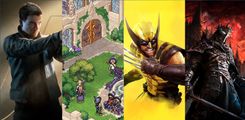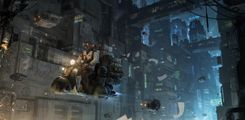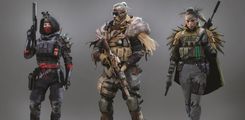Table of Contents
- What is Concept Art?
- What is Illustration?
- Comparing Concept Art and Illustration
- Career Prospects Comparison
- How to Become a Concept Artist
- How to Become an Illustrator
- Final Thoughts
Concept Art vs. Illustration: What are the Key Differences?
When it comes to concept art and illustration in the gaming, film and TV industry, they are often mentioned in the same breath, but they serve distinctly different purposes. We take a look at the differences between the two!
Both fields require impressive artistic ability so it is easy to get confused between the two. Both involve using digital techniques to make beautiful artwork but concept art is more focused on developing ideas and designs during the pre-production and production phase, such as designing characters, environments and props.
Meanwhile, illustration takes an already confirmed design, and illustrates a stand-alone artwork that is used to sell an idea, key moment or product such as a movie poster, a card game artwork or splash art for a video game character.
In this blog, we’ll take a look at the difference between concept art and illustration a bit closer, so that you can understand the key differences between the two, and decide what type of artist you may be needing to hire, or if you're an artist, determine what sort of career path you may want to follow.
What is Concept Art?
Concept art is the design phase that is used during the pre-production and production stages in films, video games, animation, and other creative projects.
Concept artists take an idea and use digital art techniques to design how it will look visually. While concept art may seem purely creative, it is also practical work that helps collaboration across departments, such as 3D modellers.
By providing concept art of characters, environments, and props, concept art will help to establish the style, tone, and overall aesthetic of the project while working with real-world constraints such as budget, technology or time.
The work begins in the planning stages, with a creative brief. The brief will outline the idea, challenges and photo references. For example, a concept artist may be given a brief for a medieval dock, which may need to be historically accurate or fit the project's unique fantasy rules. From here, the artist will create a rough concept such as black and white sketches to explore various ideas and possibilities which will then go through revisions and feedback rounds before committing to a final design.
Concept artists also help to produce blue-sky paintings, exploratory pieces designed to brainstorm freely (usually at the beginning of a project), alongside more grounded production paintings, which focus on finalized designs ready for 3D modellers to use.
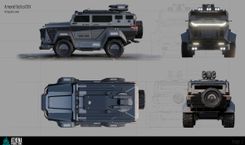
Concept artists focus on the early stages of production, using sketches, design variations, and exploratory work to develop design ideas for characters, environments and props.
What is Illustration?
Illustration uses digital art techniques to communicate ideas or tell stories. Unlike concept art, which often supports the development of a larger project, illustration is typically created as a stand-alone piece or to accompany written or visual narratives. From book covers to movie posters, illustrations are designed to grab attention and convey a specific mood, message, or story, often through the use of an artistic style that aligns with the project style, target audience, and purpose.
One of the defining features of illustration is its versatility across different media. In literature, illustrations bring life to children's books. In graphic novels and comic books, illustrations carry the weight of storytelling, weaving together text and visuals to create the story and narrative. Similarly, in the gaming industry, illustrators create detailed and dynamic artwork for card game illustrations, loading screens, and promotional materials, selling the idea of a video game's world or characters.
For example, the splash screens for League of Legends depicts characters in the classic LoL art style in a storytelling setting or moment, often showing the idea or theme of the character.
The quality of finish in illustration is often high, as illustrations are meant to be polished and striking. As such, artists often have longer timescales compared to iterative concept artwork, which has a much faster turnaround.
Illustration serves as both an artistic and communicative medium, blending technical skill - such as 3D and digital painting techniques - and creativity to produce high-quality artwork.
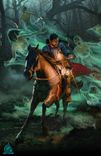
Illustration uses digital art techniques to communicate ideas or tell stories. Our 2024 Halloween Illustration is a great example of telling and illustrating a moment in the story.
Comparing Concept Art and Illustration
While concept artists and illustrators share the same artistic skills, they are not the same role. Both have a strong grasp of composition, lighting and color, but the goals of their artwork differ significantly.
Concept artists focus on the early stages of production, using sketches, design variations, and exploratory work to develop design ideas for characters, environments and props. This work is iterative and helps to guide the production team. In contrast, illustrators specialize in creating polished, finished pieces that often serve as standalone pieces or promotional material for products like books, games, or advertisements.
The work context also separates the two roles. Concept artists, often working as visual development artists (otherwise known as vis dev artists), need to be problem-solvers who can work in a collaborative environment. A concept artist has to use their artistic skill, combined with pragmatic thinking, to ensure that the function and form of the design make sense and can be translated by other teams, such as 3D modellers and animators.
On the other hand, illustrators can operate as generalists or in specialized positions, focusing on creating highly detailed and aesthetic visuals without the constraints of production feasibility.
For freelancers, the differences become even more apparent. Freelance positions for concept artists often demand fast turnarounds and an ability to adapt to a team’s vision, while freelance illustrators may take on more independent commissions where their personal style and artistic voice are key.
In summary, while concept artists and illustrators share the same foundational skills, their roles are defined by their purpose and end-goals. Concept artists must be versatile and prioritize functionality, whereas illustrators typically emphasize presentation and storytelling in their finished work.
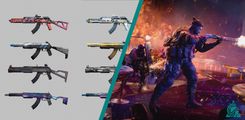
Concept art focuses more on design, meanwhile illustration focuses on creating a stand-alone artwork that is used to sell an idea, key moment or product.
Career Prospects Comparison
Both concept artists and illustrators can enjoy creative career paths, but their roles cater to different industries and demand unique skill sets.
For concept artists, opportunities exist in multiple entertainment art fields, such as the film and video game industry, where their primary task is to design and develop the visual style of projects during the vis dev phase.
In contrast, illustrators can find work in a wide range of industries such as gaming, publishing, advertising, or creating standalone pieces such as book covers, or card game illustrations.
The game industry provides career options for both fields, with concept artists focusing on environments, characters, and props for game worlds, while illustrators might design key art, promotional imagery, or loading screens.
Both careers are very competitive, and social media plays a significant role in sharing portfolios. This increases visibility but also amplifies competition from fellow creatives.
From a financial perspective, both concept artists and illustrators can be employed full-time on a weekly or salary basis, particularly in large studios, while freelancing opportunities may charge by hourly or daily rates, as well as on a per-project or per-image basis.
Ultimately, both fields can offer a rewarding career, with concept art appealing to those drawn to problem-solving and designing, while illustration suits artists who prefer creating story-driven, polished artwork.
How to Become a Concept Artist
Becoming a successful concept artist requires a combination of strong foundational skills, such as composition, lighting, and color, along with a creative approach to problem-solving, design, and storytelling to assist the team from initial brainstorming to the realization of a compelling, cohesive project.
Environment concept art includes many different components that help define the world or setting of a project. Composition plays a crucial role in guiding the viewer's attention, while mood paintings, for example, are used to convey the tone and emotion in the scene—from creepy dungeons to peaceful landscapes.
Meanwhile, character design defines the look, personality, and backstory of characters. Aspiring character concept artists should begin by practicing essential drawing skills, such as perspective and anatomy. For example, understanding anatomy and zoology is an important skill for designing believable characters and creatures with accurate bone and muscle structure. Character concept artists will also need to be able to create turnarounds/orthos (orthographic views) and expression sheets, which are organized in a detailed, multi-view layout to serve as guides for 3D modelers and production teams.
A significant part of any type of concept art task involves creating design variations and idea explorations. Artists must be able and willing to iterate on their designs, experimenting with different shapes, forms, and silhouettes to find the perfect fit for a project.
Tips and Tricks
- Many learning programs whether in-person or online offer practical exercises, portfolio development, and help prepare you to enter the industry. Self-taught routes are easily accessible nowadays, such as online courses, mentorships, or workshops that focus on the skillsets of concept art. Great online platforms we recommend include CGMA, Learn Squared and ArtStation Learning.
- Always have an online portfolio! You can use online communities such as ArtStation or DeviantArt which can help your work be discovered by recruiters or open doors for freelance opportunities.
- Mentorships, or programs from award-winning artists or experienced professionals can be a fantastic way to learn the fundamentals of concept art. One of the most significant benefits of studying under industry mentors is access to constructive feedback. Professional artists often guide students through the process of concept art, teaching them how to refine their designs and giving advice on job searches.
- Gaining industry experience can be incredibly hard, as entry-level roles are extremely competitive and rarely available. However, freelancing jobs - whether commissions from individuals or organizations - can be a fantastic way to learn how to be a commercial concept artist capable of taking feedback and acting on it.
- Joining an online community, such as Patreon groups, Discord servers, or private forums, can be a great space to share your work, get feedback from peers, network, and find a sense of community as you pursue your goal.
💡 Athena Tips: We always recommend that wherever you are choosing to learn, that you have the opportunity to learn from experienced professionals who have worked, or are currently working in the industry. Whether gaming, film or TV, these industries move quickly and artists need to be up to date with the latest workflows and technologies.
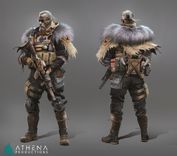
Being able to do 'turnarounds' to show the front and back of a design, whether characters, props or vehicles is an incredibly important skill for a concept artist to have.
How to Become an Illustrator
Becoming an illustrator involves developing a unique artistic voice and mastering the technical skills required to create a beautifully rendered image.
Illustrators work across various industries, from gaming and advertising to animation and publishing, each demanding its own set of skills. Aspiring illustrators should begin by focusing on fundamental techniques like drawing, composition, and lighting, as these are essential for creating eye-catching art, which is what illustration is all about.
Tips & Tricks
- A strong professional portfolio is a non-negotiable to break into the illustration industry. This should showcase your artistic and technical ability, whether with characters, environments, or action-packed keyframes. Including pieces that demonstrate an understanding of the art fundamentals will help you stand out to clients and recruiters.
- One-on-one mentorships can be incredibly beneficial to give you first hand knowledge and personalized advice on building up your portfolio, navigating career opportunities, and developing a distinctive artistic voice. We recommend politely emailing or messaging artists you admire on their social media to see if they offer mentorship opportunities!
- Art schools or online programs may offer formal training which can provide a solid foundation of illustration techniques and industry-standard software. For self-taught artists, online tutorials and mentorships are excellent resources for building skills and understanding industry expectations.
- Freelance illustration projects are a common way to work or gain experience. You will need to be able to manage contracts, deadlines, and client relationships.
- Joining communities is a great way to stay motivated, get feedback and meet other artists in the industry.
- Explore YouTube channels run by well-established artists, as they often provide valuable tips and tutorials to help you on your illustration journey.
💡Athena Tip: Whether you are self-taught, or went to an art school, remember that at the end of the day, your portfolio speaks volumes!
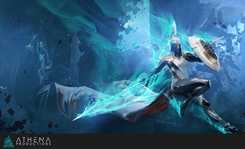
Illustrators need to develop a unique artistic voice and master technical artistic skills to create beautifully polished artwork.
Final Thoughts
It’s important to remember that concept art and illustration serve different purposes in the creative process.
Concept art focuses on exploring ideas and designs for characters, environments, or props, often as part of pre-production for games, films, or other media. It emphasizes function, iteration, and problem-solving to guide the overall design.
In contrast, illustration is typically a polished, standalone artwork that tells a story or conveys a specific message. While concept art is about generating and refining ideas and designs, illustration is about delivering a finished piece.
At Athena Productions, we craft stunning concept art and story-driven illustrations that captivate and inspire. Whether for games, films, or TV, our talented team is ready to make your ideas a reality. Get in touch today and let’s create something extraordinary!

